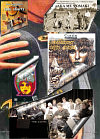Alexandria Virtual Cultural Centre of WA
The Three Nexal registers:
Identity, peripheral cultural industry, alternative cultures
Nikola Janović and Rastko Močnik
11.7. Alternative cultures
We can epitomise alternative cultural production by the practices of “squatting”: alternative cultures are metaphorical “squatters” in contemporary society – and are often literary squatters in contemporary metropolises.
The squats are among the most innovative and propulsive cultural agents. This is true about alternative cultural agents in general, but the squats enjoy definite independence from financial sources and authorities. Being without a future, they do not have to care about good relations with the sources of financing, and do not have to flatter the authorities. Relations with artists and other performers rely upon common ideological horizon, and are to a large extent extra-economically motivated. This is a fortiori true for their nexus-related activities, not only because the Balkans themselves often resemble a gigantic squat – but also because of the serious obstacles better regulated approaches are likely to encounter when dealing with the Balkans.
Upon the squat scene, nexus works in both directions. This is how one of the participating Ljubljana alternative artists puts it: “When we go abroad, we go to the Balkans. The scene there is not as commercialised as elsewhere in Europe, and people there still listen to each other.”XXXIX This particular area of cultural life mostly relies on personal connections: not only on the production side (aesthetic affinities, the logic of the Maussian gift, reciprocal exchange “in kind”, specific management and organisational styles), but also on the side of audiences (the events are advertised through informal social channels, financial participation of the audience is often “according to one's capacities”, etc.). As a consequence, it is within this “margin of the margin” that the presence of groups with nexus-connections has the most powerful cultural impact.
Since the alternative seems to be the only domain of cultural practices that consciously, directly and often programmatically confront the present historical situation, we now need to come back to the general socio−historical considerations.
The process of commodification of all spheres of society, including “culture”, is an old motive of social critique, and has particularly been developed within the anti-capitalist critical tradition, and here especially in the Marxian tradition. The absence of confrontation with this critical tradition in contemporary cultural policy debates is rather fascinating.XXXX In the light of this tradition, concerns with “quality, quantity, and access” seem rather naïve, since these “questions” have already been resolved by the commodification of “culture”. Towards the mid-1960s, it has generally been accepted that commodification in the sphere of “culture” marginalises concerns with “quality” and introduces an urge towards "quantity", that it prefers quantitative comparability to qualitative distinctness, homogenises cultural production and makes it a mass-production. Cultural critics then maintained that “capitalism” is, by its very nature, hostile to the authentic immanence of the immediate life-experience of which “culture” has traditionally been the defender and promoter. At that early point, and before the sophistication introduced by structuralism and its “post-”, debates were not, and could not be, about “quality, quantity, and accessibility” – since those issues have already been resolved, even without having been posed as “questions”, by the market-automatism as, according to theoretical consensus of the epoch, the general form of capitalist class-domination. The debate, at the time, was rather about the nature of this class-domination, and, as a consequence, about the strategy to adopt to oppose it. The two limit-positions which defined the horizon of the debate were, roughly speaking, theory of “reification”XXXXI and the “society of spectacle”XXXXII position.
For the reification-theory, progressive commodification of all the spheres of society is the work of the systemic logic of capitalism which progressively imposes its criterion of social valorisation of labour, first triumphant in the “material” economy, upon all other social activities. The totality of social life is finally integrated into capitalist economy, and subjected to its immanent logic defined by Marx as “commodity fetishism”. Relations among humans take on the fantastic form of relations among things, and these reified relations are characterised by abstractness, quantifiability, and translatability into the value-form of the “general equivalent” (i.e. “money”). This historical process does away with all the “pre-capitalist” forms of sociability, and so it does away with the specific forms of “culture”. An implicit tenet of this theory is that, although capitalism introduces a progressive movement into society “in general”, its impact is not similarly progressive in the sphere of “culture” where capitalism is anti-cultural. No specific cultural policy can be proposed within this horizon, since culture in its specificity has already been abolished within the capitalist system, or, if anything remains of it, it is an anachronistic relict of pre-capitalist epochs or, at best, of the early stages of the ascent of bourgeoisie when it was still mimicking aristocratic ways. The strategy that followed from this theoretical position was socialist revolution.
Contrary to the supposition of the reification theory that the development of capitalism is a sort of mechanical expansion, the “society of spectacle” position holds that the expansion of the capitalist logic across society brings about a kind of “dialectical reversal” through which the dominant and the generalised social relation becomes the “spectacle”. The result of the final grip of capitalism over society is not “reification”, but its contrary, namely the “spectacularisation” of inter-human relations. It is not circulation of “things”, but that of “images” that determines social relations in contemporary capitalism. This description rather fairly depicts the working of capitalism in its “core” during the B-phase of a systemic cycle.XXXXIII At the point when the drive to “infinite accumulation of capital” has exhausted available “niches” of material production, the solution is found in a process which appears, from the point of view of the capital, as the “flight” of the capital towards financial transactions (as opposed to investment or immediate commodity transactions). This process has been well elaborated in the “economic cycles” theories.XXXXIV Less attention has been paid to the way the process appears, not from the point of view of capital production, but from the point of view of the individual consumer. From this perspective, the process actually appears as an autonomous flux of “images” for solid structural reasons, among which the necessity of “aesthetic” diversification of otherwise homogeneous products, the necessity to “create” demand in a context of “hyper-production”, and with the expansion of the “entertainment industry” which, being the production of “representations”, is not much more than an immediate “materialisation”, in all the phases of its economy, of the two “necessities” and is consequently one of the few branches of “material” production (together with, e.g., military industry) which can still expand after the completion of the A-phase of the systemic cycle. While the “society of spectacle” position agrees with the “reification” theory that the solution cannot be but the (revolutionary) abolition of capitalism, it differs from the reification theory in that it considers that the revolution should start with the destruction of the “cultural” dimension of contemporary social relations. For, according to the perspective of Debord and his followers, “culture” is not a “sphere” of society, it is the dimension of reproduction which permeates contemporary social relations of domination and exploitation.XXXXV
Alternative cultural practices seem closer to Debord than to the Marxists. They situate themselves outside the apories of culturification of economy and economisation of culture, and try to construct a new social sphere for their operations and for their products. Nuclei of this new “sphere” are often called “autonomous zones”; if any cultural and more widely social action is to be possible in these zones, they have to be connected. It is this necessity that directs alternative cultures towards the nexus phenomena.
To conclude, we may describe the three modes of cultural policy that presently work upon the nexus phenomena in the following way;
1.Political establishments mostly act repressively against the nexus phenomena or, at their best, try to recuperate them for the type of social reproduction they themselves endeavour to promote.
2.Peripheral cultural industries are parasitic upon the nexus phenomena, and produce multiple unintentional side-effects, some of which can be diverted towards alternative further elaboration.
3.Finally, alternative cultural practices are vitally dependent upon the nexus phenomena which are among the very few historical supports they can find for their operations..
PAGE - 8 PREVIOUS PAGE NEXT PAGE PAGE - 8
Alexandria - Acting on the brighter future for the professional arts in Australia






